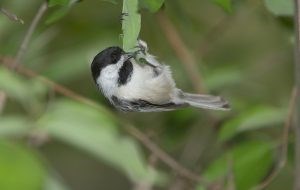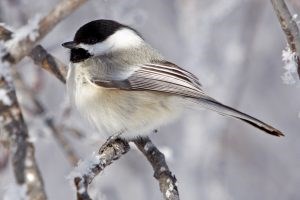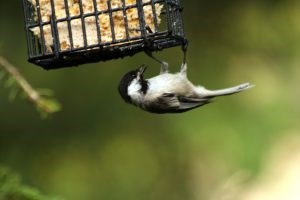This content was originally published by the Longmont Observer and is licensed under a Creative Commons license.
Small and inquisitive, the black-capped chickadee is a favorite at backyard bird feeders. This is one of the species birders learn first because of the chickadee’s curiosity and ubiquitous nature. Because migrating songbirds often associate with chickadee flocks, they are a good place to look for new and interesting species. Birds that associate with chickadee flocks will respond to the alarm calls of the chickadees.
An interesting fact about chickadees is that each fall, they allow neurons containing old information to die and replace them with new neurons. This is thought to allow them to adapt to their environment and changes in their social flocks more easily.
These are small, compact birds with thin short bills. Black-capped chickadees are only 4.5-5.5 inches in length and they weigh only 0.3-0.4 ounces. Although males are slightly larger than females, it is very difficult to tell them apart. As their name indicates, black-capped chickadees have a solid black cap and a black bib with white cheeks. The back is a solid greenish-grey color and the sides have a buffy tinge to them. The wings are streaked with white and black. The belly is white and the tail is light grey.

Black-capped chickadees are found throughout the northern two-thirds of the United States. They are mostly nonmigratory. The highest concentrations of black-capped chickadees in Colorado are found between 5,000 and 9,000 feet. They are found in mixed woodlands, deciduous forests, edges, thickets, and urban areas. They are most commonly found in open woods and forest edges.
Black-capped chickadees eat primarily insects, seeds, and berries, but the diet varies depending on the season. In the summer, they eat mostly insects whereas in the winter, up to half of their diet consists of seeds and berries.
During the fall, black-capped chickadees may store their food in caches although they are known to do this throughout the year. Their favorite bird feeder foods are sunflower seeds, peanuts, suet, peanut butter, and mealworms.
When eating seeds, black-capped chickadees will peck a small hole in the shell and then chip off small parts of the seed to eat. As they eat, they enlarge the hole.
Black-capped chickadees are capable of hanging from a twig or a leaf and picking food off the surface due to specialized leg muscles. Most of the time, they will take their food someplace other than where they got it to eat it. This is dependent on how large the piece of food is and how far it is to a hiding place. Black-capped chickadees have also been reported to feed on the fat of dead animals.

Black-capped chickadee pairs usually form in the fall. The pair will then remain together in a winter flock. In the event that one member of the pair dies during the winter, a new pair may form in the spring. Pairs are usually monogamous and may remain together for several breeding seasons. In the early spring, the male will feed the female. Scientists are unsure whether this is part of courtship behavior because the courtship behavior of black-capped chickadees has not been well-studied.
Black-capped chickadees may excavate their own nesting cavity, but they are also known to use nest boxes, natural cavities, or abandoned downy woodpecker cavities. When nest boxes are used, they prefer to excavate wood shavings or sawdust rather than taking an empty nest box. Nests are typically placed one to ten feet above the ground. Nesting cavities are excavated in decaying wood and the nest is lined with plant fibers, wool, moss, feathers and insect cocoons. Both sexes help to excavate the cavity, whereas the female takes care of building the nest inside the cavity. Old nests are rarely reused.

Females will lay 1-13 eggs with the average being 6-8. Only one clutch is laid per year, but if the nest is destroyed, another clutch may be laid. Eggs are white and are dotted with brown. Only the female incubates the eggs. The incubation period lasts for 12-13 days. During incubation, the male brings food to the female.
The young are born naked and helpless (altricial). The female will brood the young for the first few days after they hatch and the male brings food to the nest for the nestlings. The young fledge at about 16 days after hatching unless the nest is disturbed, in which case they may leave earlier. Both the male and the female will continue to help feed the young for two to four weeks after they fledge, after which time the young disperse. The young will join a winter flock, but are not usually found in the same flock as their parents.
Black-capped chickadees are often heard before they are seen. Listen for their characteristic chick-a-dee-dee-dee song or their fee bee song. If you spot a chickadee flock (known as a banditry), look for some of the other birds that typically associate with them such as woodpeckers, nuthatches, warblers, and vireos.
Chickadees are easy to attract to backyard birdfeeders that contain suet, sunflower seeds and peanuts. They will readily use hanging feeders that swing in the wind and window feeders. You can also attract black-capped chickadees by putting up a nest box as long as you put it up well before breeding season. If you choose to use a nest box, remember that chickadees are more attracted to boxes that are filled with sawdust or wood shavings so they have something to excavate. You can learn more about nest boxes at Project NestWatch. These inquisitive little birds are a fun and welcome sight.


